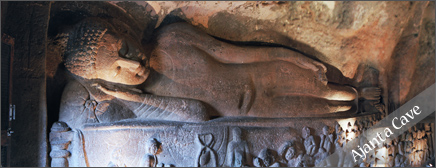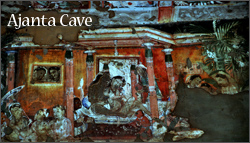 |
| Page -- > 1, 2 |
| Highlights of some of the major
caves |
 |
| Here, briefly, are some of the highlights of the caves. In the
Cave 26, the sculpture is elaborate and beautiful though the painted frescoes
are incomplete. The arched chapel window set in an elegantly simple
façade, is repeated in an elaborate frontage in Cave 19 with its
complete Chaitya and a slender votive stupa enclosing a standing Buddha at the
far end. Of particular note is a sculpture of a seated Nagaraja with his
consort and female attendant. |
| Cave 16 is an elegant Vihara with an inscription that mentions the
king and his minister who had the cave built. Here a towering Buddha sits
preaching. He is flanked by attendants with fly whisks. |
 |
There are undamaged portions of the wall paintings that are clear
and vibrant in Caves 1, 2, 16 and 17. Cave I has the well known Bodhisattva
Padmapani which is a wonderful portrayal of tender compassion. A gentle figure
holding a lotus delicately in one hand. |
|
| In the same cave is the golden figure
of Avalokiteswara, elaborately adorned. The women, nymphs, princess and
attendants are elegant and beautifully attired. Here also is a lively panel of
dancing girls and musicians. In Cave 2 there is a detailed panel of Queen
Maya’s dream, of the white elephant which was interpreted by royal
astrologers to mean the birth of an illustrious son. The row upon row of
Buddhas, can be seen in this cave. In Cave 17, there is a flying apsara in a
fashionable embroidered turban and splendid jewellery. |
It is worth walking away from the caves in
order to look back on to the horseshoe gorge. The ingenuous water cistern
system can be seen which must have provided water for the monks and their
visitors. Ajanta was on the ancient trade route leading to the coast so there
must have been considerable activity and many visitors. Nobody really knows
what life was like in those times and visitors can interpret the past as they
wish, which is perhaps yet another secret charm of Ajanta. |
 A
Matter of History View this article on the Ajanta and Ellora Caves A
Matter of History View this article on the Ajanta and Ellora Caves |
|
Phase I: 2 nd century BC to 1 st century BC
Caves 9 & 10: Chaitya
Halls or shrines
Caves 12 & 13: Viharas or monasteries
Phase II: 5
th century AD to 6 th century AD
Caves 19,26 & 29: Chaitya Halls or shrines
Caves 1-7, 11,
14-18, 20-25, 27 & 28: Viharas or monasteries |
| Top |
| Unfinished Caves: 3, 5, 8, 23-25, 28 & 2 |
|
| There are plenty of tours operated from Aurangabad to the Ajanta Ellora Caves.
These tours cover all the other attractions enroute the caves from Aurangabad. |
 Nearest airport is Aurangabad 108 kms. Nearest airport is Aurangabad 108 kms.
|
 Jalgaon, 58 kms. on Central Railway is a convenient railhead. Jalgaon, 58 kms. on Central Railway is a convenient railhead. |
 Mumba-Ajanta, 491 kms. via Jalgaon. Mumbai-Ajanta, 487kms. via Manmad.
Mumbai-Ajanta, $99 kms. Via Pune.
State Transport and luxury buses run from Aurangabad and Jalgaon toAjanta. Mumba-Ajanta, 491 kms. via Jalgaon. Mumbai-Ajanta, 487kms. via Manmad.
Mumbai-Ajanta, $99 kms. Via Pune.
State Transport and luxury buses run from Aurangabad and Jalgaon toAjanta. |
| Top |
|
 MTDC Hotel at Ajanta-a choice of single (2 blocks) and double (2 blocks) rooms.
Fardapur : selfcontained (1 block-14 beds) Fardapur (Kanhaiya Kunj self
contained rooms (12blocks) group.
Accommodation ( 2 block 18 beds). MTDC Hotel at Ajanta-a choice of single (2 blocks) and double (2 blocks) rooms.
Fardapur : selfcontained (1 block-14 beds) Fardapur (Kanhaiya Kunj self
contained rooms (12blocks) group.
Accommodation ( 2 block 18 beds). |
|
| 9.00 a.m. |
|
| Ajanta, Aurangabad and Fardapur. |
|
|